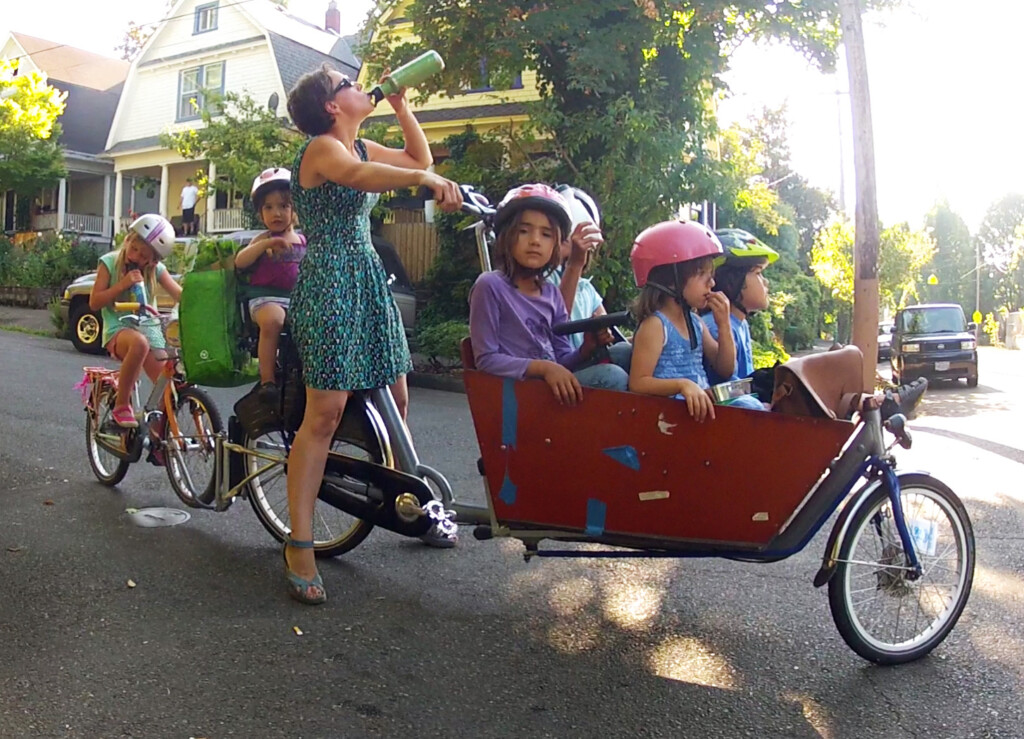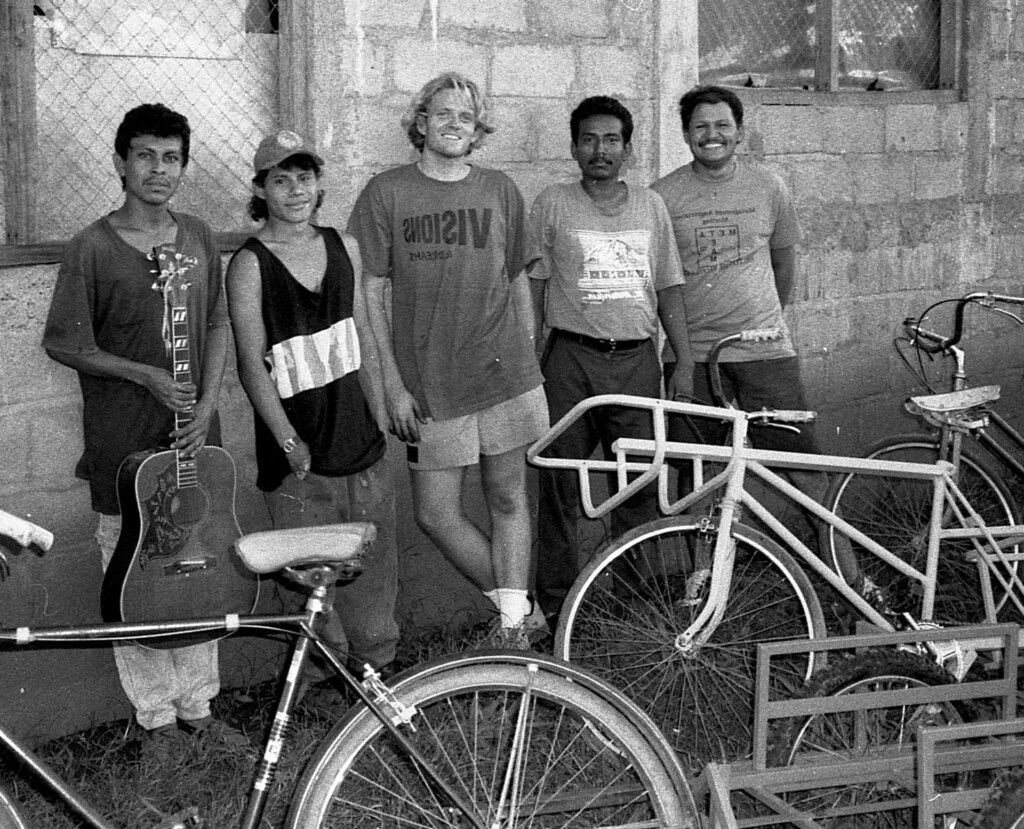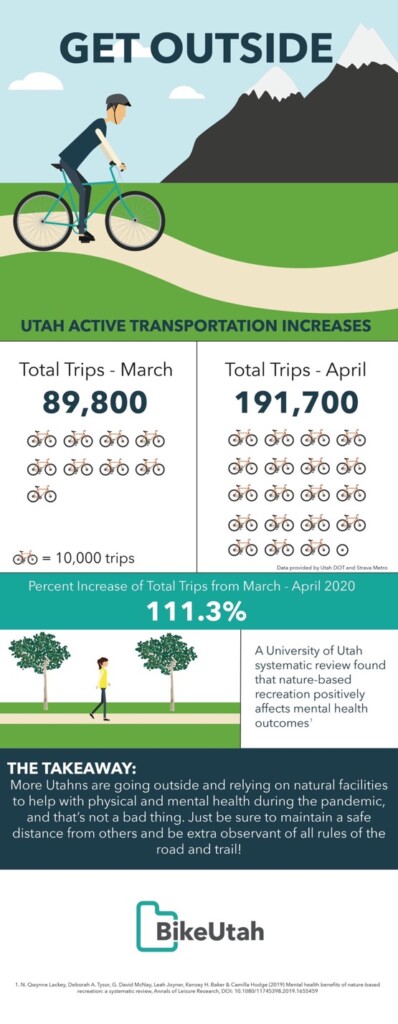If there is at least one good metric coming out of the COVID-19 pandemic, it’s the trend of bicycle trips. BikeUtah.org, citing data from the Utah Department of Transportation and Strava Metro, reported that the number of bicycle trips in April more than doubled those in March in the state. While the data represents a sample of those cyclists who are Strava members, the numbers also reflect the findings of a recent study by University of Utah researchers published last year in the Annals of Leisure Research. The conclusion: “positive association between nature-based recreation and mental health, including improvements in affect, cognition, restoration, and well-being, and decreases in anxiety and depression symptoms.”
The theme resonates in the exuberantly resourceful 2019 documentary Motherload, directed by Liz Canning, which highlights the numerous dimensions of why so many are turning to cargo bikes – most notably, mothers – as their preferred mode of transit in urbanized areas. The Utah Film Center will present the film in a livestream screening Tuesday, May 26, at 7 p.m. The event includes a talkback with representatives from the Bicycle Collective, Bike Utah and cargo-biking moms. Viewers will be able to access the event through this Utah Film Center link.

As the film’s perky opening portrays, Canning’s love for biking is noteworthy for where she lives. Fairfax, California in Marin County is heralded as the seminal destination for developing the recreational sport of mountain biking, including having one of the most skilled biking teams of any high school in the U.S.
After giving birth to twins 12 years ago, she moved her work to home and lamented that she no longer had the freedom or convenience to ride her bike whenever the whim hit. Then, she noticed some video posts featuring parents riding cargo bikes with long tail designs, which becomes a liberating force for numerous reasons, as she soon discovers.
The documentary is a crowdsourced project in every categorization possible – and not just because of its Kickstarter genesis. The film features a crowdsourced collage of stories not just from Fairfax but also Australia, Germany, Ghana, Nicaragua and the United Kingdom. Indeed, cargo bikes are becoming ubiquitous for various reasons. Certainly, the climate crisis is one obvious connection for changing behavior. And, of course, there are the mental health benefits of having access for recreational purposes, as emphasized recently by how the social distancing measures of a pandemic can still be met while cycling. But, cargo bikes also are a compelling equalizer for social and economic purposes, a comfortably affordable option, especially as witnessed in Ghana and Nicaragua. Meanwhile, cargo e-bikes for family riding can be relatively expensive, as some have decided to sell their cars or take out loans either at low or zero interest rates.
Mothers (and fathers) are among the most visible in the documentary, their presence framed in part by Canning’s efforts to contextualize how the culture of bicycles ties into the history of the suffrage movement and women’s rights in general. One of the most prominently featured is Emily Finch, who carries all six of her children on a long-tail cargo bike. And, the credits at the end of the film indicate that there is now a seventh child.

More plainly, the cargo bike is the 21st century version of the old family van—just far more ecofriendly. Several cities also are experimenting with cargo e-bikes as delivery options for packages that weigh up to 400 pounds or measure 60 cubic feet in volume. In Miami, the shipping company DHL Express is running a pilot, as the company is targeting a short-term goal of “clean pickup and delivery solutions” for 70% of its operations by 2025.
Canning also captures some of the pushback, particularly from motorists who are irked that they have to share the road with riders on cargo bikes. There are scenes of motorists shouting at mothers on cargo bikes while accusing them of endangering their children.

Before the pandemic, one could have watched Motherload and thought that Canning’s optimism about the cargo bike culture might be too bubbly or overstated to suggest a real transformation in the mindset of many communities. Few believe that millions willingly would trade their cars in for cargo e-bikes or rely primarily on public transit.

But, the pandemic also seems to have accelerated more serious considerations of the claims made in Motherload. As vehicular traffic slowed dramatically with either voluntary or mandated quarantine measures, many municipalities, including Salt Lake City, decided to open streets and block off lanes to accommodate larger volumes of pedestrians and cyclists while adhering to demands for safe social distancing.
A recent survey of approximately 1,200 Salt Lake City residents indicated that streets should be designed and arranged primarily for moving people rather than for accommodating the flow of vehicular traffic to mitigate congestion. As Building Salt Lake reported, “In fact, residents ranked movement of vehicles as their lowest priority, indicating support for an attempt by Salt Lake City to move away from nearly a century of car-first street planning and toward one that ties streets to the existing and desired land use in areas they pass through.”
This coincides with efforts by the city’s transportation division to recategorize nearly 10,000 street segments under new types that will emphasize people-first spaces—an undertaking that will occur gradually over the next several years. As the Building Salt Lake feature indicated, some of the new typologies of SLC streets would incorporate some of the neighborhood designations Seattle developed, in order to create a “calm traffic environment.” City officials plan to ask for public input later this summer before presenting the plan to the City Council for approval.
Canning’s crowdsourcing approach suited Motherload perfectly. Meanwhile, she is soliciting additional stories related to biking during the pandemic and how families and individuals are sustaining themselves during the pandemic.
